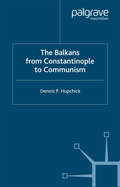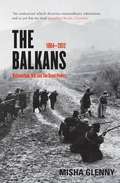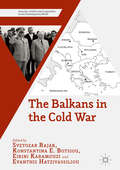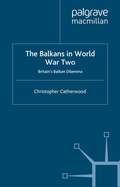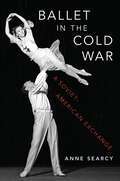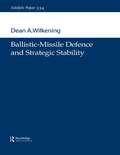- Table View
- List View
Balkan Worlds: The First and Last Europe (Subsidia Balcanica, Islamica Et Turcica Ser. #Vol. 1)
by Traian StoianovichEncompassing the period from the Neolithic era to the troubled present, this book studies the peoples, societies and cultures of the area situated between the Adriatic Sea in the west and the Black Sea in the east, between the Alpine region and Danube basin in the north and the Aegean Sea in the south. This is not a conventional history of the Balkans. Drawing upon archaeology, anthropology, economics, psychology and linguistics as well as history, the author has attempted a "total history" that integrates as many as possible of the avenues and categories of the Balkan experience.
‘Balkanization’ and the Euro-Atlantic Processes of the: Back to the Future (ISSN)
by Liridona Veliu AshikuThis book explores how ‘balkanization’ as a discourse underpins the policies of the European Union (EU) and the North Atlantic Treaty Organization (NATO) toward the Western Balkans. It shows how EU and NATO policies have emerged from, and led to, the constant reinvention of the unity of the West through ‘balkanizing’ the region and illustrates how this dynamic is maintained by and instrumentalized for the political elites. Through a genealogical analysis that stretches from the Balkans Wars to more recent events such as North Macedonia’s change of name in 2018, the author shows how Western policies have aimed at recreating the united West on the back of the ‘broken’ Balkans. The book will appeal to scholars and students of Southeast Europe, International Relations, Political Science, Peace and Conflict Studies and History.
‘Balkanization’ and the Euro-Atlantic Processes of the: Back to the Future (ISSN)
by Liridona Veliu AshikuThis book explores how ‘balkanization’ as a discourse underpins the policies of the European Union (EU) and the North Atlantic Treaty Organization (NATO) toward the Western Balkans. It shows how EU and NATO policies have emerged from, and led to, the constant reinvention of the unity of the West through ‘balkanizing’ the region and illustrates how this dynamic is maintained by and instrumentalized for the political elites. Through a genealogical analysis that stretches from the Balkans Wars to more recent events such as North Macedonia’s change of name in 2018, the author shows how Western policies have aimed at recreating the united West on the back of the ‘broken’ Balkans. The book will appeal to scholars and students of Southeast Europe, International Relations, Political Science, Peace and Conflict Studies and History.
The Balkans: From Constantinople to Communism
by D. HupchickThe tragedies of Bosnia and Kosovo are often explained away as the unchangeable legacy of 'centuries-old hatreds'. In this richly detailed, expertly balanced chronicle of the Balkans across fifteen centuries, Hupchick sets a complicated record straight. Organized around the three great civilizations of the region - Western European, Orthodox Christian and Muslim - this is a much-needed guide to the political, social, cultural and religious threads of Balkan history, with a clear, convincing account of the reasons for nationalist violence and terror.
The Balkans, 1804-2012: Nationalism, War And The Great Powers (PDF)
by Misha GlennyThe landmark history of the Balkans, fully revised and updated.
The Balkans Beyond Nationalism and Identity: International Relations and Ideology
by Pavlos HatzopoulosFor decades we have come to accept that nationalism formed the basis of the modern history of the Balkans. In this bold and controversial study, Pavlos Hatzopoulos turns this assumption on its head. Through a ground-breaking examination of the non-nationalist ideologies in the Balkans during the interwar period, Hatzopoulos calls into question the supposedly inherent connection between the Balkans and nationalism and argues that nationalism does not form the sole ordering principle of the modern history of the Balkan region. Focusing on the ideologies of communism, liberal internationalism and agrarianism, Hatzopoulos examines how these interact with nationalist ideology. He demonstrates how non-nationalist theories challenge the nationalist view of the Balkans as the sum of several national spaces. He even questions the nationalist understanding of the very term 'the Balkans'. The Balkans Beyond Nationalism and Identity revisits contemporary debates on a region that is still a European crisis point and challenges the nation-centric understanding that permeates it. In proposing a description of 'the Balkans' as a contested political concept, the book argues for a completely fresh interpretation of the region's composition.
The Balkans in International Relations: A Case Study Of The Balkans (pdf)
by Branimir M Jankovic Bosko MilosavljevicThe Balkans in the Cold War (Security, Conflict and Cooperation in the Contemporary World)
by Svetozar Rajak Konstantina E. Botsiou Eirini Karamouzi Evanthis HatzivassiliouPositioned on the fault line between two competing Cold War ideological and military alliances, and entangled in ethnic, cultural and religious diversity, the Balkan region offers a particularly interesting case for the study of the global Cold War system. This book explores the origins, unfolding and impact of the Cold War on the Balkans on the one hand, and the importance of regional realities and pressures on the other. Fifteen contributors from history, international relations, and political science address a series of complex issues rarely covered in one volume, namely the Balkans and the creation of the Cold War order; Military alliances and the Balkans; uneasy relations with the Superpowers; Balkan dilemmas in the 1970s and 1980s and the ‘significant other’ – the EEC; and identity, culture and ideology. The book’s particular contribution to the scholarship of the Cold War is that it draws on extensive multi-archival research of both regional and American, ex-Soviet and Western European archives.
The Balkans in World War Two: Britain’s Balkan Dilemma
by C. CatherwoodBetween 1939 and 1941 Britain had a terrible dilemma. She was keen to see Turkey, Bulgaria, Greece, Romania and Yugoslavia join the Allies against Nazi Germany. But the 1939 Molotov Ribbentrop Pact had changed everything: the Balkan countries were far more afraid of Stalin than of Hitler. Britain and France were also concerned about the Soviets giving so much oil to Germany: in 1940 Britain almost went to war with the USSR in an attack on the Caucasus. This book looks at how Britain tried to solve these dilemmas and ultimately failed to do so.
The Balkans on Trial: Justice vs. Realpolitik (Routledge Advances in European Politics)
by Carole HodgeThis book assesses the International Criminal Tribunal for former Yugoslavia’s (ICTY) legacy and examines the conflicting intersection of law and politics in the search for justice, both thematically and through close analysis of some of the major trials. It analyses the related case brought against Serbia and Montenegro by Bosnia and Herzegovina at the International Court of Justice (ICJ), as well as the Ganic case in London where the ICTY and ICJ findings were challenged. The book addresses the following questions: To what extent the political climate in which the ICTY was conceived, and continues to operate, has affected the declared aims of its founders? Have political considerations and political correctness, and the perceived need for political stability and democratic transition, at times proved an obstacle to the administration of justice? Are some of the acknowledged failings of international policy in the 1990s finding some resonance in more recent court proceedings? This highly relevant and comprehensive book will be of interest to students and scholars of political science, international relations, transitional justice, Balkan area studies, human rights law, international criminal and peace and conflict studies.
The Balkans on Trial: Justice vs. Realpolitik (Routledge Advances in European Politics)
by Carole HodgeThis book assesses the International Criminal Tribunal for former Yugoslavia’s (ICTY) legacy and examines the conflicting intersection of law and politics in the search for justice, both thematically and through close analysis of some of the major trials. It analyses the related case brought against Serbia and Montenegro by Bosnia and Herzegovina at the International Court of Justice (ICJ), as well as the Ganic case in London where the ICTY and ICJ findings were challenged. The book addresses the following questions: To what extent the political climate in which the ICTY was conceived, and continues to operate, has affected the declared aims of its founders? Have political considerations and political correctness, and the perceived need for political stability and democratic transition, at times proved an obstacle to the administration of justice? Are some of the acknowledged failings of international policy in the 1990s finding some resonance in more recent court proceedings? This highly relevant and comprehensive book will be of interest to students and scholars of political science, international relations, transitional justice, Balkan area studies, human rights law, international criminal and peace and conflict studies.
Ballet Dream: Two Magical Adventures in One! Special (Secret Princesses #1)
by Rosie BanksSecret Princesses is a gorgeous new series about magical princesses and best friends. In this winter special there are two stories for even more magical fun! Trainee Secret Princesses, Charlotte and Mia, are excited about christmas celebrations at the magical Wishing Star Palace. But evil Princess Poison is determined to spoil everyone's festive fun. Can Charlotte and Mia grant the wishes of two best friends and make sure that their Chrstmas dreams come true?Join Charlotte and Mia in this brilliant adventure full of princess sparkle and seasonal excitement!
Ballet in the Cold War: A Soviet-American Exchange
by Anne SearcyIn 1959, the Bolshoi Ballet arrived in New York for its first ever performances in the United States. The tour was part of the Soviet-American cultural exchange, arranged by the governments of the US and USSR as part of their Cold War strategies. This book explores the first tours of the exchange, by the Bolshoi in 1959 and 1962, by American Ballet Theatre in 1960, and by New York City Ballet in 1962. The tours opened up space for genuine appreciation of foreign ballet. American fans lined up overnight to buy tickets to the Bolshoi, and Soviet audiences packed massive theaters to see American companies. Political leaders, including Khrushchev and Kennedy, met with the dancers. The audience reaction, screaming and crying, was overwhelming. But the tours also began a series of deep misunderstandings. American and Soviet audiences did not view ballet in the same way. Each group experienced the other's ballet through the lens of their own aesthetics. Americans loved Soviet dancers but believed that Soviet ballets were old-fashioned and vulgar. Soviet audiences and critics likewise appreciated American technique and innovation but saw American choreography as empty and dry. Drawing on both Russian- and English-language archival sources, this book demonstrates that the separation between Soviet and American ballet lies less in how the ballets look and sound, and more in the ways that Soviet and American viewers were trained to see and hear. It suggests new ways to understand both Cold War cultural diplomacy and twentieth-century ballet.
Ballet in the Cold War: A Soviet-American Exchange
by Anne SearcyIn 1959, the Bolshoi Ballet arrived in New York for its first ever performances in the United States. The tour was part of the Soviet-American cultural exchange, arranged by the governments of the US and USSR as part of their Cold War strategies. This book explores the first tours of the exchange, by the Bolshoi in 1959 and 1962, by American Ballet Theatre in 1960, and by New York City Ballet in 1962. The tours opened up space for genuine appreciation of foreign ballet. American fans lined up overnight to buy tickets to the Bolshoi, and Soviet audiences packed massive theaters to see American companies. Political leaders, including Khrushchev and Kennedy, met with the dancers. The audience reaction, screaming and crying, was overwhelming. But the tours also began a series of deep misunderstandings. American and Soviet audiences did not view ballet in the same way. Each group experienced the other's ballet through the lens of their own aesthetics. Americans loved Soviet dancers but believed that Soviet ballets were old-fashioned and vulgar. Soviet audiences and critics likewise appreciated American technique and innovation but saw American choreography as empty and dry. Drawing on both Russian- and English-language archival sources, this book demonstrates that the separation between Soviet and American ballet lies less in how the ballets look and sound, and more in the ways that Soviet and American viewers were trained to see and hear. It suggests new ways to understand both Cold War cultural diplomacy and twentieth-century ballet.
Ballistic-Missile Defence and Strategic Stability (Adelphi series)
by Dean A. WilkeningShould the US deploy ballistic-missile defences? The arguments for and against are becoming increasingly polarised. This paper offers what is currently lacking in the debate: a quantitative analysis of how well defences would have to work to meet specific security objectives, and what level of defence might upset strategic stability.
Ballistic-Missile Defence and Strategic Stability (Adelphi series #334)
by Dean A. WilkeningShould the US deploy ballistic-missile defences? The arguments for and against are becoming increasingly polarised. This paper offers what is currently lacking in the debate: a quantitative analysis of how well defences would have to work to meet specific security objectives, and what level of defence might upset strategic stability.
Ballistic Missile Defense In The Post-cold War Era
by David B DenoonWith the end of the Cold War and the visibility of U.S. Patriot missile defenses during the 1991 Gulf War, the cost and benefits of ballistic missile defense systems (BMD) need to be re-evaluated. In this detailed and balanced study, David Denoon assesses new types of short-range and intercontinental missile defenses. In the post Cold War era, two fundamental changes have made missile defense for the United States and its military forces more compelling: The United States and Russia no longer see each other as direct threats and there has been a dramatic proliferation of ballistic missile capability in the Third World. Consequently, U.S. forces deployed overseas are more likely to be at risk and, eventually, the United States itself could become vulnerable to missile threats. With these changes in mind, David Denoon analyzes the current BMD dilemma, arguing that active defenses against missiles should be seen as a form of insurance against catastrophe. He assesses the likelihood of missile attacks and the appropriate level of investment for the United States to defend against such attacks. The book provides an assessment of deterrence and the performance of the Patriot missiles during the 1991 Gulf War, critiques the Strategic Defense Initiative, and analyzes the prospects for new types of short-range and intercontinental missile defenses.
Ballistic Missile Defense In The Post-cold War Era
by David B DenoonWith the end of the Cold War and the visibility of U.S. Patriot missile defenses during the 1991 Gulf War, the cost and benefits of ballistic missile defense systems (BMD) need to be re-evaluated. In this detailed and balanced study, David Denoon assesses new types of short-range and intercontinental missile defenses. In the post Cold War era, two fundamental changes have made missile defense for the United States and its military forces more compelling: The United States and Russia no longer see each other as direct threats and there has been a dramatic proliferation of ballistic missile capability in the Third World. Consequently, U.S. forces deployed overseas are more likely to be at risk and, eventually, the United States itself could become vulnerable to missile threats. With these changes in mind, David Denoon analyzes the current BMD dilemma, arguing that active defenses against missiles should be seen as a form of insurance against catastrophe. He assesses the likelihood of missile attacks and the appropriate level of investment for the United States to defend against such attacks. The book provides an assessment of deterrence and the performance of the Patriot missiles during the 1991 Gulf War, critiques the Strategic Defense Initiative, and analyzes the prospects for new types of short-range and intercontinental missile defenses.
Ballistic Missile Proliferation in Non-Nuclear States: The Origins of Ballistic Missile Programmes in the Middle East (Routledge Global Security Studies)
by Karim El-Baz Ali Ghanbarpour-DizboniThis book offers an exploration of ballistic missile proliferation in the Middle East and also delves into the geopolitical landscape to unveil a narrative of contemporary Middle Eastern history.The central focus of this book is to decipher the pivotal moments when three regional powers of the Middle East - Egypt, Saudi Arabia, and Iran - embraced ballistic capabilities as a strategic response to military vulnerabilities. The authors contend that the very essence of ballistic proliferation incorporates a tactical rationale provided by military needs that varies from one state to another, and it is upon the assessment of these military needs that the decision to procure ballistic missiles is made. Offering a blend of theoretical insights and primary sources-based case studies, this book dissects the decision-making processes that spurred these states to choose ballistic missiles, despite their inefficiencies in delivering conventional payloads. The absence of an effective air force emerges as a catalyst, triggering what the authors term a ‘moment of ballistic consciousness.' Spanning three diverse regimes, the work provides a rich historical tapestry and untangles the complexities of political decisions with military implications, providing a fresh perspective on global power dynamics. This narrative sheds light on the intersection of military strategy, geopolitical realities, and the pursuit of ballistic capabilities that shapes the world's security landscape.This book will be of much interest to students of arms control, nuclear proliferation, Middle Eastern politics, and International Relations.
Ballistic Missile Proliferation in Non-Nuclear States: The Origins of Ballistic Missile Programmes in the Middle East (Routledge Global Security Studies)
by Karim El-Baz Ali Ghanbarpour-DizboniThis book offers an exploration of ballistic missile proliferation in the Middle East and also delves into the geopolitical landscape to unveil a narrative of contemporary Middle Eastern history.The central focus of this book is to decipher the pivotal moments when three regional powers of the Middle East - Egypt, Saudi Arabia, and Iran - embraced ballistic capabilities as a strategic response to military vulnerabilities. The authors contend that the very essence of ballistic proliferation incorporates a tactical rationale provided by military needs that varies from one state to another, and it is upon the assessment of these military needs that the decision to procure ballistic missiles is made. Offering a blend of theoretical insights and primary sources-based case studies, this book dissects the decision-making processes that spurred these states to choose ballistic missiles, despite their inefficiencies in delivering conventional payloads. The absence of an effective air force emerges as a catalyst, triggering what the authors term a ‘moment of ballistic consciousness.' Spanning three diverse regimes, the work provides a rich historical tapestry and untangles the complexities of political decisions with military implications, providing a fresh perspective on global power dynamics. This narrative sheds light on the intersection of military strategy, geopolitical realities, and the pursuit of ballistic capabilities that shapes the world's security landscape.This book will be of much interest to students of arms control, nuclear proliferation, Middle Eastern politics, and International Relations.
Ballistics: Theory and Practice
by Beat P. KneubuehlThis work provides comprehensive, practice-oriented coverage of ballistics. It explains the principles and calculation methods for the main four areas of ballistics, regardless of calibre, drawing on numerous facts, observations and examples from the author’s decades of experience. Interior ballistics: The characteristics of explosive materials (detonating agents and propellants), methods for calculating gas pressure and the velocity of projectiles and rockets during the acceleration phase, alternative systems for accelerating projectiles and the acceleration of fragments. Intermediate ballistics: The dynamics of the moment at which the projectile leaves the muzzle and propellant gas is ejected from the barrel, effects on the person or structure supporting the weapon and approaches to resolving questions regarding shots from close range in criminology and forensic medicine. Exterior ballistics: The forces acting on a projectile and methods for calculating them, models for calculating trajectories (including the ballistic coefficient), gyroscopic projectile stabilization theory and aerodynamic optimization of projectiles. Terminal ballistics: Empirically-derived facts and data. The principles of ballistic protection design, ballistic testing problems and possible solutions and a comprehensive discussion of ricochets – a matter of considerable importance in forensics. This book is intended for ballisticians, military personnel, police officers, criminologists, shooting range specialists, sport shooters, hunters and anyone else with an interest in ballistics.
Ballistik: Theorie und Praxis
by Beat P. KneubuehlDieses Werk bietet eine umfassende Darstellung der Ballistik mit engem Bezug zur Praxis. Es beschreibt kaliberunabhängig die Grundlagen und Rechenmodelle in den vier Hauptgebieten der Ballistik mit vielen Fakten, Hinweisen und Beispielen aus der jahrzehntelangen Erfahrung des Autors.Innenballistik: Eigenschaften von Explosivstoffen (Zünd‐ und Treibmittel), Berechnungsverfahren des Gasdruckes und der Geschwindigkeit von Geschossen und Raketen während der Beschleunigung, alternative Systeme der Projektilbeschleunigung, Beschleunigung von Splittern.Abgangsballistik: Dynamik des Momentes, in dem das Geschoss die Mündung der Waffe verlässt und die Pulvergase aus dem Rohr strömen, Auswirkungen auf den Waffenträger, Grundlage für die Nahschussprobleme in Kriminalistik und Rechtsmedizin.Außenballistik: Kräfte, die auf das Geschoss einwirken und deren Bestimmung, Beschreibung der Rechenmodelle zur Bestimmung von Flugbahnen (inkl. „Ballistic Coefficient“), Theorie der gyroskopischen Stabilisierung von Geschossen, der aerodynamischen Optimierung von Flugkörpern.Endballistik: Zusammenstellung experimentell ermittelter Fakten und Daten. Grundlagen für den Entwurf von Schutzeinrichtungen, Probleme der Prüfung von ballistischem Schutz, einschließlich möglicher Lösungen, ausführliche Darstellung des Abprallens von Geschossen, dem speziell in der Forensik große Bedeutung zukommt.Das Werk wendet sich an Ballistiker und Armeeangehörige, Polizeiangehörige und Kriminalisten sowie Schießstandsachverständige, Sportschützen, Jäger und weitere Interessierte.
Ballistik: Theorie und Praxis
by Beat P. KneubuehlDie vorliegende 2. Auflage wurde vollständig durchgesehen, aktualisiert und mit einigen Ergänzungen versehen sowie mit einem Kapitel über „Ballistische Messtechnik“ erweitert. Sie bietet weiterhin eine umfassende Darstellung der Ballistik mit engem Bezug zur Praxis. Sie beschreibt die Grundlagen und Rechenmodelle in den vier Hauptgebieten der Ballistik mit vielen Fakten, Hinweisen und Beispielen aus der jahrzehntelangen großen Erfahrung des Autors.Innenballistik: Explosivstoffe (Zünd- und Treibmittel), Berechnungsverfahren des Gasdruckes und der Geschwindigkeit von Geschossen und Raketen, Möglichkeiten der Projektilbeschleunigung, Beschleunigung von Splittern.Abgangsballistik: Ereignisse, die das Geschoss beim Verlassen der Mündung begleiten, Ausströmen der Pulvergase, Auswirkungen auf den Schützen oder den Waffenträger, Grundlage für die Schussentfernungsbestimmung in Kriminalistik und Rechtsmedizin.Außenballistik: Kräfte, die auf das Geschoss einwirken, Beschreibung der Rechenmodelle zur Bestimmung von Flugbahnen, Lösungen des Randwertproblems, Theorie der gyroskopischen Stabilisierung von Geschossen, aerodynamischen Optimierung von Flugkörpern.Endballistik: Die Wechselwirkung eines Geschosses mit vielen Materialien, neu auch mit Glas und Keramik, Zusammenstellung experimentell ermittelter Fakten und Daten, Probleme der Prüfung von ballistischem Schutz, ausführliche Darstellung des Abprallens von Geschossen, dem speziell in der Forensik große Bedeutung zukommt.Ballistische Anwendungen: in der Kriminalistik, bei Sicherheitsfragen und -problemen auf Schießplätzen und in Schießanlagen, neu die Berechnung der Außenballistik von Schrotgarben in ihrer ganzen Ausdehnung.Ballistische Messtechnik: Grundzüge der Messtechnik für Geschwindigkeit, Druck und Flugverhalten von Geschossen, bildgebende Verfahren, historische Messkonzepte.
Ballot: Ten Episodes that Shaped India’s Democracy
by Rasheed Kidwai543 Lok Sabha seats. More than 4,000 state constituencies. Over 800 million voters. The world’s largest democracy. From the time of its inception, democracy in India has been dubbed ‘miraculous’ by the world’s media, and its elections as a spectacular exercise in human management. In Ballot, Rasheed Kidwai takes us through his pick of seminal elections that have shaped Indian democracy both at the centre and in select states. Highlighting the unique challenges faced by a country that adopted universal adult franchise at the very outset, profiling personalities who have triggered ground-shifts, and analysing the causes and consequences of key electoral episodes, he traces the very evolution of India’s democratic process. Through insightful commentary and colourful anecdotes, Ballot provides a brief, incisive examination of India’s most momentous elections.
Ballot Box China: Grassroots Democracy in the Final Major One-Party State (Asian Arguments)
by Kerry BrownSince 1988, China has undergone one of the largest, but least understood experiments in grassroots democracy. Across 600,000 villages in China, with almost a million elections, some three million officials have been elected.The Chinese government believes that this is a step towards `democracy with Chinese characteristics'. But to many involved in them, the elections have been mired by corruption, vote-rigging and cronyism.This book looks at the history of these elections, how they arose, what they have achieved and where they might be going, exploring the specific experience of elections by those who have taken part in them - the villagers in some of the most deprived areas of China.


